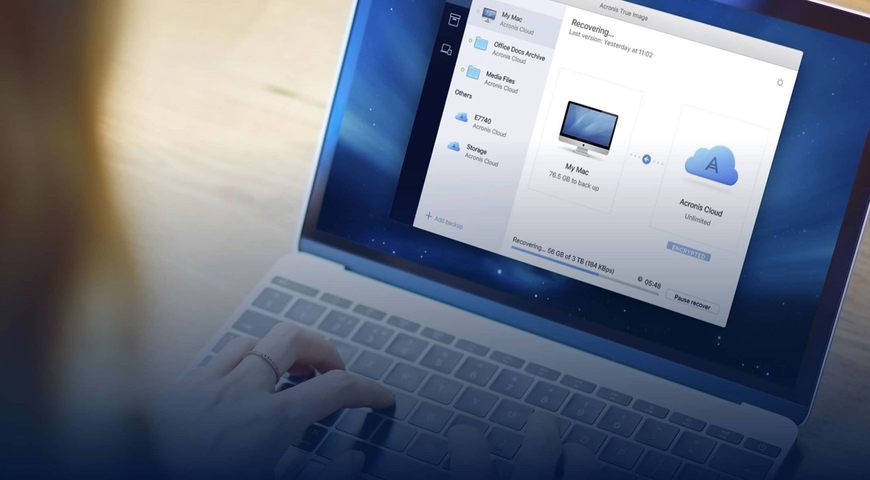
Whether it's your child’s soccer game, your dog hiding under a blanket, or a beautiful sunset, your smartphone captures all of the moments you never want to forget. But even if you're using the cloud to sync everything across your devices, what happens when you accidentally click "delete" or find a ransomware attack encrypted your photo files? Suddenly, you’re scrambling to recover those lost moments.
Photo recovery software can help you regain access to those files – but only if you act quickly. Let’s take a look at what you need to know about recovering a deleted or missing photo, including:
- What photo and video recovery is (and isn't)
- How to use a photo recovery tool
- Why, for recently deleted photos, recovery speed matters
- How to choose photo recovery software
What photo and video recovery is (and isn't)
Photo and video recovery give you a way to access files and reinstall them on your device if you accidentally delete them. If you've ever hit the "delete" button when you meant to hit the "return" button, you know how easy it is to accidentally remove a file. Even worse, when you've accidentally deleted something, locating it on your hard drive often becomes a tedious, time-consuming task.
Photo and video recovery tools can help you locate and recover photo and video files easily. With the right tool, you can search your entire hard drive for the lost file you want, inspect it to see if it is intact enough to be recovered and, if so, restore it onto your device.
Photo and video recovery, however, is not the same as restoring from a backup. Rather than locating the original version, restoring from backup involves retrieving a copy of the missing photo that you made previously. With a backup, you are guaranteed to have a copy of the image or video that you can grab.
Photo recovery leaves more to chance since the location on the computer’s hard disk where the picture was stored might have been overwritten by new information — making it impossible to recover the lost file.
If you don’t have a backup of the photo or video, however, having a utility that will find the original is the best shot you have at saving that memory.
How to use a photo recovery tool
Your photo recovery tool should be something intuitive. Looking for a file in every possible location takes time that you don't always have, which means the prospect of an intensive search process might deter you from recovering that memory.
Most top-rated photo recovery tools incorporate a "wizard" style walk-through feature. Similar to software installation wizards, the photo recovery software will commonly display a user-friendly interface with a window that allows you to select from the available hard drives and scan them to review their contents and find the one you want to recover.
In some cases, the recovery tool provides a list that incorporates file previews or localized file names. These options often help in speeding up the photo recovery process.

For recently deleted photos, recovery speed matters
In addition to helping you recover from an accidental deletion, photo recovery can also give you peace of mind. A malware or ransomware infection can delete files without you doing anything. In other cases, you might have saved a file on a USB drive and deleted it thinking you didn't want it anymore, only to realize you need that file later.
The success rate of photo recovery options can depend on how you store pictures and your understanding of how hard drives work.
When you save a file, the operating system creates a marker that helps it find the location, similar to a set of driving directions. When you delete a file, your computer erases that map but the information remains on the hard drive. Think of it as shutting down your GPS driving app: The directions to the address are gone, but the building you visited still exists. On a computer, the file stays on your hard drive until new information overwrites it. Your information can be located as long as no new information writes over it.
Once the photo is overwritten, you cannot recover it – just as you can’t revisit a building once it’s been torn down.
Photo recovery on a solid-state hard drive
When it comes to USB flash drives or external solid state drives (SSDs), photos and videos can usually be restored using a data recovery program as long as the disk space was not overwritten by new information.
When it comes to recovering accidentally deleted files from solid-state storage, however, there is one notable exception: internal SSDs. That’s because internal SSDs follow an optimization protocol called TRIM, which instantly eliminates files from the drive when they are deleted.
Photo recovery from a virus
In the case of a virus, using a recovery tool gives you the opportunity to find out whether too much damage has been done to the file. In some cases, a virus or a disk with bad sectors can ruin the file's integrity. If that happens, even finding the original file won’t let you revive it – you’ll only restore the photo if you have a copy in your backup.
Photo recovery from a memory storage card
If you're using a camera or device that doesn't automatically upload to a cloud, you might be using an SD card or other type of memory card for storage. That poses two potential risks.
- First, removable media used in multiple devices easily gets infected. If you use shared computers and insert that removable media into an infected computer, the virus can corrupt your files.
- Second, if you're trying to make space for more images on a card, you may delete a photo only to realize later that you didn’t want to.
Photo recovery from a memory card can be tricky, but with the right recovery tool, it's possible. If you didn't add more photos immediately, then SD photo recovery using an undelete tool can help you find it again.
How to choose photo recovery software
With so many photo recovery tools available, choosing the right one for your needs requires thinking about how you use and store your information. Asking some of these questions can help you make the right choice:
- Does it reliably locate a variety of files?
- How easily can you navigate the located files?
- How effortlessly can you recover those files?
- Does it recover files after emptying the Recycle Bin?
- Can it recover photos damaged by an HDD's partition or a disk with bad sectors?
If you're looking for a simple, easy-to-use tool, then you want something that walks you through the process. If you're more technologically savvy, then you may be comfortable with a solution that requires more knowledge of file-naming conventions and hard disk manipulation.
Final Thoughts
Losing photos and memories is everyone's personal nightmare. And while regular backups can ensure your photos are safe, the right photo recovery tool can help you spend more time making memories and less time worrying about losing them. With Acronis Revive, you can more easily locate and recover accidentally deleted files, while being able to estimate how likely you are to recover a file.
So whether you accidentally deleted a file, a video was removed by a virus, or you realize you still need a photo after you deleted, Acronis Revive gives you the best chance of restoring the missing data – bringing your memories back to life.
About Acronis
A Swiss company founded in Singapore in 2003, Acronis has 15 offices worldwide and employees in 50+ countries. Acronis Cyber Protect Cloud is available in 26 languages in 150 countries and is used by over 20,000 service providers to protect over 750,000 businesses.




